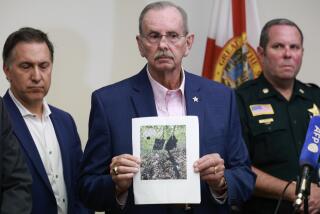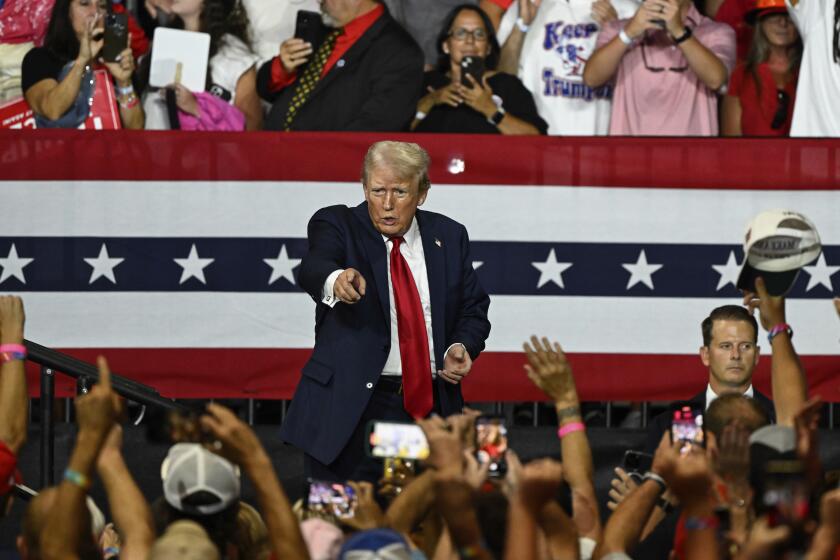Fed’s Decisions Tied to ‘Natural’ 6% Jobless Rate
With little public debate, the Federal Reserve Board is increasingly basing interest rate decisions on the controversial assumption that the nation’s unemployment rate cannot be reduced much below 6% without igniting inflation.
At an annual Federal Reserve conference on economic and labor policy held this weekend in Jackson Hole, Wyo., Fed officials privately acknowledged that they have come to rely on the 6% jobless figure as a key benchmark for setting interest rates.
The nation’s central bank already has raised interest rates five times this year in an effort to curb the threat of rising prices that often accompany rapid economic growth. While Fed officials concede there has been little evidence so far of surging prices, they argue that the relatively fast pace of growth this year would ultimately fuel inflation if they failed to intervene.
In public and private alike, Fed officials insist that their long-term goal is not to force the country into a recession for the sake of low inflation but to keep the economy on an even keel, growing at a rate that can be sustained without rapid price increases. Their efforts to reduce inflation have been widely misunderstood, they complain.
“Monetary policy actions geared to promoting price stability will enhance real growth over time,” argued Jerry Jordan, president of the Federal Reserve Bank of Cleveland and one of the participants in the weekend conference.
Yet increasingly, Fed officials tend to gauge whether the economy is overheating partly by referring to what they call the “natural rate of unemployment.” That is defined by economists as the lowest level of unemployment that can be sustained without putting inflationary pressures on the economy.
In the 1970s, economists used a benchmark called “full employment,” and it was generally agreed to mean an unemployment rate of about 4%. But today, Fed officials and many economists believe that the economy cannot long sustain an unemployment rate below about 6% without causing wages and prices to spiral upward.
Fed officials here acknowledged there is still considerable debate about the precise level of “natural” unemployment. Some conservatives believe that it could be as high as 6.5%, while others believe it could be slightly under 6%. But there is general agreement inside the central bank that U.S. unemployment, which drifted down from 6.9% in mid-1993 to 6% last June, is very close to the natural rate. That, in turn, helps explain why the Fed has moved repeatedly in recent months to boost interest rates. Fed officials stress that they use many other economic barometers as well, but the natural rate of unemployment is clearly one of the most controversial at the central bank’s disposal.
Some Fed officials attending the Wyoming conference conceded privately that their increasing reliance on the 6% target is politically sensitive because there has been almost no debate in Congress or elsewhere about the new assumption that reducing unemployment to 4% or so is no longer a realistic goal. While some Fed officials, notably Robert Parry, president of the Federal Reserve Bank of San Francisco, have given speeches about the importance of the natural rate of unemployment, many of their colleagues admit that it is a difficult issue to raise with Congress and the public.
The new approach is particularly risky since Congress mandated in the 1970s that one of the Fed’s priorities had to be achieving “full employment.” That mandate is contained in the Humphrey-Hawkins Act, which still provides the technical guidelines the Fed is supposed to follow.
“The natural-rate hypothesis has received near-universal acceptance among academic economists since the 1970s,” said Stanford University economist Paul Krugman, who attended the weekend session. “My sense is that it is less well-accepted among policy-makers and journalists, who seem to regard it as an abstract idea whose very neatness makes it suspect. It is therefore worth pointing out that for the United States at least, the natural-rate hypothesis has a very solid basis in experience.”
The weekend conference brought together virtually every top Fed official as well as many senior Clinton Administration policy-makers and leading private economists. The discussions focused in part on the reasons for the rise in the “natural” unemployment rate during the last two decades in the United States and Europe. It also addressed government policies that might be useful in reversing the trend.
Some at the conference--notably Lawrence Katz, the Labor Department’s chief economist--argued that improved job training and school dropout prevention programs could help lower the natural rate. But few see a major role for the Fed in reducing the rate below its current level.
Fed Vice Chairman Alan Blinder noted in a speech Saturday that the Fed certainly has the ability to stimulate the economy--and thus reduce unemployment--in the short term by loosening its grip on the money supply. But over longer periods of time, he said, it cannot goose the economy and boost job creation without causing a sharp rise in inflation.
In a keynote speech, Krugman argued that the natural rate of unemployment has risen during the last generation in large part because of costly government social programs in the United States and Europe that reduce incentives for the poor to get off welfare and other assistance and return to the work force.
That trend, coupled with the increased importance of education in getting a good job, has led to a sharp rise in long-term unemployment, especially in Europe, Krugman said.
In fact, the natural unemployment rate in Europe is now thought to be about twice the U.S. level. The increase in the United States has been less extreme, in part because American social programs are less generous, Krugman observed.
But it is also because there are fewer governmental restrictions on firing or laying off workers in the United States, which means American employers are less reluctant than their European counterparts to hire new employees.
Other participants agreed with Krugman’s diagnosis.
“I suggest that a better name (for the trend) is welfare-state unemployment,” said Allan Meltzer, a conservative economist at Carnegie Mellon University.
While the United States has been able to create more jobs than Europe, it has paid a price in the form of greater income inequality, the participants agreed. Low-paying jobs are more acceptable to American workers than their European counterparts because they don’t have a generous social safety net to fall back upon when they are unemployed.
“The evidence that the United States has done better on employment growth but worse on real wages, overall productivity growth and wage inequality than Europe raises the question of whether advanced industrial nations face an inevitable trade-off between more jobs and better jobs,” Katz said.
Government training and apprenticeship programs can have an impact, Katz noted. But Krugman disagreed, saying he doesn’t believe such efforts can significantly change the natural rate of unemployment.
“There are two main alternatives: Europe can become more like America, or it can try to become more like Sweden used to be,” said Krugman. “That is, the welfare state can be scaled back, increasing the incentives for firms to offer and for workers to accept low-wage employment; or governments can try to subsidize employment at acceptable wage levels.
“The political problems with either alternative are obvious,” he continued. “Attempts to scale back the protections that have discouraged employment in Europe will, indeed already have, led to massive protests. On the other hand, if employment is to be subsidized, the money must be found somewhere. The unemployment problem of the advanced nations has no painless solutions.”
Fed Chairman Alan Greenspan argued that such a direct trade-off between a society that allows greater poverty in order to generate more jobs and one that provides a generous safety net while sacrificing job growth seems to leave little room for central bankers to act to reduce unemployment below the natural rate.
“If the trade-off is as stark as it appears, those endeavoring to address structural employment imbalances are bound to find themselves frustrated,” Greenspan said in a speech here.
More to Read
Get the L.A. Times Politics newsletter
Deeply reported insights into legislation, politics and policy from Sacramento, Washington and beyond. In your inbox three times per week.
You may occasionally receive promotional content from the Los Angeles Times.










